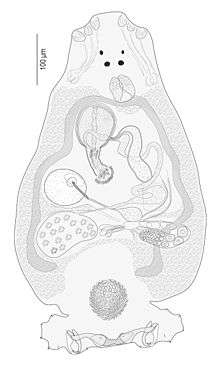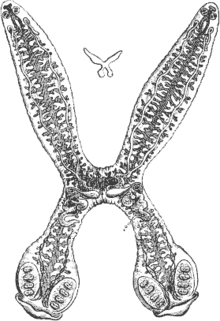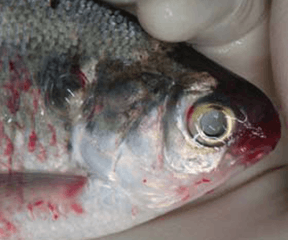Monogenea
| Monogenea | |
|---|---|
 | |
| Echinoplectanum laeve | |
| Scientific classification | |
| Kingdom: | Animalia |
| Phylum: | Platyhelminthes |
| Class: | Monogenea Carus, 1863 |
| Subgroups | |
Monogeneans are a group of ectoparasites commonly found on the skin, gills, or fins of fish. They have a direct life cycle and do not require an intermediate host. Adults are hermaphrodites, meaning they have both male and female reproductive structures (Tubbsa et al., 2005). Monogeneans have a series of hooks which are used to attach onto fish and as a result, could lead to infections.
Some monogeneans are Oviparous (egg-laying) and some are Viviparous (live-bearing). Oviparous varieties release eggs into the water. Viviparous varieties release larvae, which immediately attach to another host. The genus Gyrodactylus is an example of a viviparous variety while the genus Dactylogyrus is an example of an oviparous variety(Tubbsa et al., 2005).
Signs and Symptoms
Freshwater fish who become infected with this parasite become lethargic and end up swimming towards the surface of the water. In addition, some may be seen rubbing the bottom or sides of their skin where the parasite is located. Infected skin where the parasite is attached may show areas of scale loss and may produce a pinkish fluid. Gills that are infected may appear swollen and pale. "Pipping", which is gulping for air at the water surface could indicate severe respiratory distress(Reed et al., n.d, pp. 1).
In salt water fish, Monogeneans can infect the skin and gills, resulting in irritations to the host. Heavy infections could result in erratic swimming behavior. Affected gills may become irritated and swollen(Reed et al., n.d, pp. 1).
Characteristics
Monogenea are small parasitic flatworms mainly found on skin or gills of fish. They are rarely longer than about 2 cm. A few species infecting certain marine fish are larger and marine forms are generally larger than those found on fresh water hosts. Monogenea are often capable of dramatically elongating and shortening as they move. Biologists need to ensure that specimens are completely relaxed before measurements are taken.[1]
Monogeneans lack respiratory, skeletal and circulatory systems and have no or weakly developed oral suckers.[2] Like other flatworms, Monogenea have no true body cavity (coelom). They have a simple digestive system consisting of a mouth opening with a muscular pharynx and an intestine with no terminal opening (anus).
Monogenea are Platyhelminthes and therefore are among the lowest invertebrates to possess three embryonic germ layers—endoderm, mesoderm, and ectoderm. In addition, they have a head region that contains concentrated sense organs and nervous tissue (brain).
Like all ectoparasites, monogeneans have well-developed attachment structures. The anterior structures are collectively termed the prohaptor, while the posterior ones are collectively termed the opisthaptor, or simply haptor. The posterior opisthaptor with its hooks, anchors, clamps etc. is typically the major attachment organ.
Generally, monogeneans also are hermaphroditic with functional reproductive organs of both sexes occurring in one individual. Most species are oviparous but a few are viviparous.
Systematics and evolution
The ancestors of Monogenea were probably free-living flatworms similar to modern Turbellaria. According to the more widely accepted view, "rhabdocoel turbellarians gave rise to monogeneans; these, in turn, gave rise to digeneans, from which the cestodes were derived. Another view is that the rhabdocoel ancestor gave rise to two lines; one gave rise to monogeneans, who gave rise to digeneans, and the other line gave rise to cestodes" [1] .
There are about 50 families and thousands of described species.
Some parasitologists divide Monogenea into two (or three) subclasses based on the complexity of their haptor: Monopisthocotylea have one main part to the haptor, often with hooks or a large attachment disc, whereas Polyopisthocotylea have multiple parts to the haptor, typically clamps. These groups are also known as Polyonchoinea and Heteronchoinea, respectively. Polyopisthocotyleans are almost exclusively gill-dwelling blood feeders, whereas Monopisthocotyleans may live on the gills, skin and fins.
Monopisthocotylea include:
- Genus Gyrodactylus, which has no eyespots and is viviparous.
- Genus Dactylogyrus, which has four eyespots and is oviparous. This is one of the largest metazoan genera, with at least 970 species.
- Genus Neobenedenia, which is much larger and lives on the skin of many tropical marine species, causing problematic infections in marine aquaria.
All of which can cause epizootics in freshwater fish when raised in aquaculture.
Polyopisthocotylea include:
- Genus Diclidophora, which is primarily found in marine fish and primitive freshwater fish like sturgeons and paddlefish.
- Genus Protopolystoma, found in aquatic clawed toads (Xenopus species).
Ecology and life cycle
_egg.tif.jpg)
Monogeneans possess the simplest life cycle among the parasitic platyhelminths. They have no intermediate hosts and are ectoparasitic on fish (seldom in the urinary bladder and rectum of cold-blooded vertebrates). Although they are hermaphrodites, the male reproductive system becomes functional before the female part. The eggs hatch releasing a heavily ciliated larval stage known as an oncomiracidium. The oncomiracidium has numerous posterior hooks and is generally the life stage responsible for transmission from host to host.
No known monogeneans infect birds, but one (Oculotrema hippopotami) infects mammals, parasitizing the eye of the hippopotamus.
References
- ↑ Roberts, S. Larry & John Janovy, Jr. Foundations of Parasitology
- ↑ flatworm :: Annotated classification - Britannica Online Encyclopedia
- ↑ Theunissen, M., Tiedt, L. & Du Preez, L. H. 2014: The morphology and attachment of Protopolystoma xenopodis (Monogenea: Polystomatidae) infecting the African clawed frog Xenopus laevis. Parasite, 21, 20. doi:10.1051/parasite/2014020
1.) L.A. Tubbsa et al. (2005). Effects of temperature on fecundity in vitro, egg hatching and reproductive development of Benedenia seriolae and Zeuxapta seriolae (Monogenea) parasitic on yellowtail kingfish Seriola lalandi. International Journal for Parasitology(35), 315-327.
2) Reed, Peggy et al. Monogenean Parasites of Fish. Institute of Food and Agricultural Sciences. . http://www.aces.edu/dept/fisheries/education/ras/publications/Update/Monogenean%20Parasites%20of%20Fish.pdf
External links
- Monogenea – ectoparasitic flukes (flatworms) - Clinical Sciences

